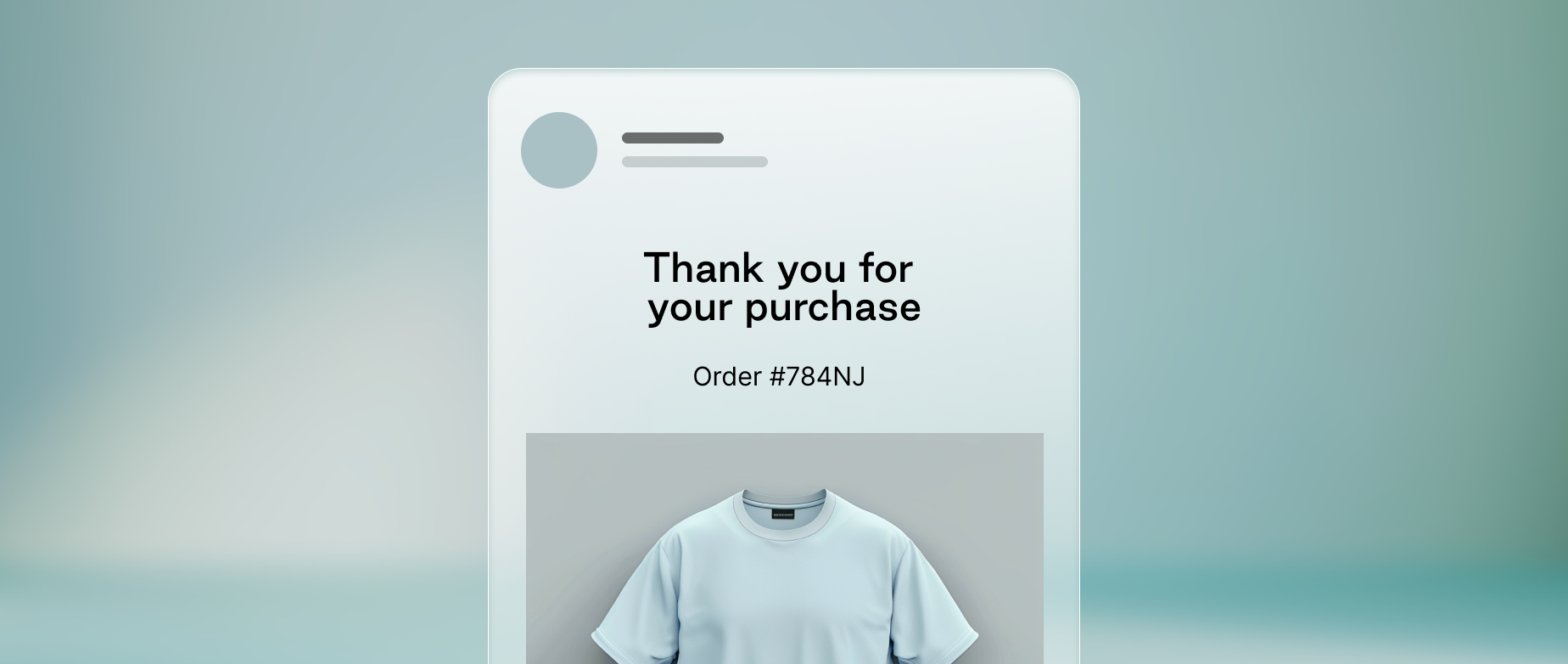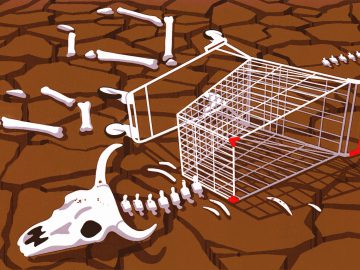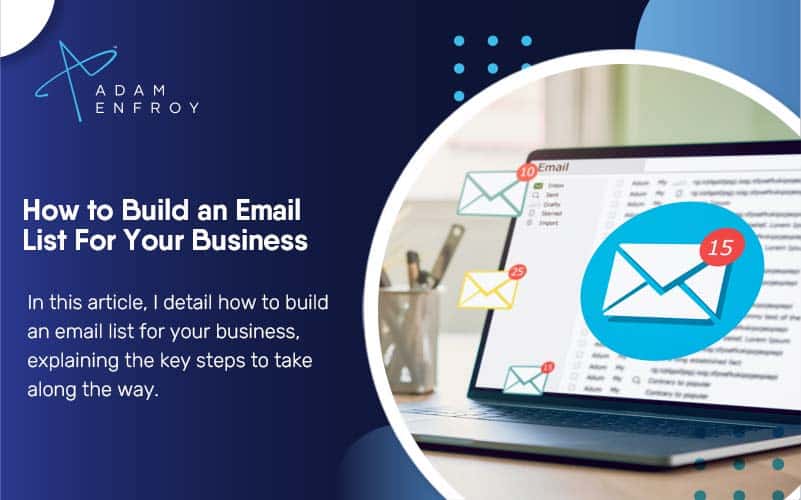You might have heard that email marketing helps you sell more, converts like crazy, and has the best ROI of any marketing channel.
These are all true statements, but you’d be forgiven for thinking email is always about selling, selling, selling. Email marketing is a powerhouse sales channel, but it’’s not only about making the sale; it’’s also about nurturing the connection.
Your brand-new customers are primed and ready to become raving fans, and you can use email to help get them there faster. Those first few interactions after purchase are crucial for setting the tone and creating a lasting positive impression.
The best part? Increasing customer retention rates—turning first-time buyers into loyal customers—can dramatically affect your business. Even a small increase in customer retention can lead to a significant boost in profitability.
So yes, creating fans might not be the same as cranking up your conversion rates, but it’s still important for your business’s bottom line. By building relationships and creating a memorable post-purchase experience, you’’re investing in the long-term success of your brand.
This guide will dive deep into post-purchase emails, explore why they’re so crucial, share real-life email marketing examples to inspire your next campaign, and provide actionable tips for crafting emails that keep your customers coming back for more.
What are post-purchase emails?
Post-purchase emails are automated email messages you send after a customer buys something, often part of a campaign. These campaigns are sent at different times: immediately after the purchase, during delivery, and days after the product has arrived.
A post-purchase email series contains both transactional and sales-oriented emails. For example, sending a shipping confirmation email informing the customer their order is en route. Upsell and cross-sell emails are powerful post-purchase emails that provide value after the first purchase and encourage customers to return for more.
These emails usually contain details such as:
- Order number
- Receipts
- Product details
- Shipping information
- Contact information for support
9 post-purchase email examples
- Order confirmation emails
- Shipping confirmation
- How-to information emails
- Reminder emails
- Survey emails
- Customer information emails
- Surprise and delight emails
- User-generated content emails
- Upsell/cross-sell
1. Order confirmation emails
A simple thank you goes a long way. Although it might seem like straightforward advice, an order confirmation email is an excellent way to establish trust with customers after they’ve made a purchase.
An on-brand, amusing, or interesting thank you message can help you stand out when you’re top of mind for your customer: right after they’ve handed over their payment information and committed to their purchase.
Everyone expects a confirmation email, and transactional emails get great open rates—up to double the average open rate of promotional emails. So why not make the most of this opportunity to connect with your customers?
Haoma emails recent customers to thank them and plant a tree for every purchase. The brand also lists the items in their order to give shoppers peace of mind that their shipment is being processed.
Haoma plants one tree for every purchase. Really Good Emails
2. Shipping confirmation
When customers order something online, one of their most pressing concerns is when the order will arrive at their door.
Shipping notification emails are not only helpful, they’re expected. But you don’’t need to stop at the standard “Hey, your order is on its way” emails. With a bit of creativity, you can turn these transactional messages into memorable brand touchpoints.
If you use Shopify Shipping, you can customize your email notifications to include your brand color, logo, and even the phrasing of the notification. You’’ll find those options under Settings in the Notifications section. Once there, you can add your logo, set its size, and add your brand color to create a cohesive, on-brand experience.
Recess uses a fun tone to let customers know their shipment is coming. The brand confirms the customer’s address and adds a Track Order button that lets shoppers see where their package is in the delivery process.
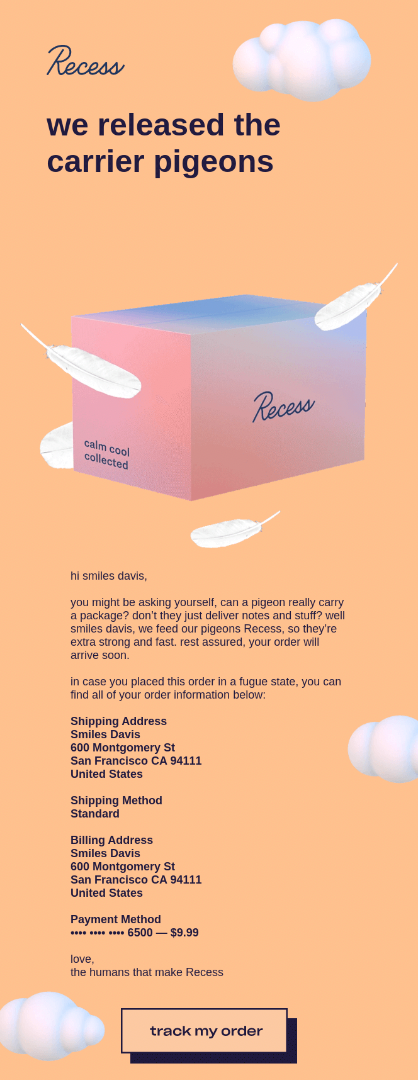
Recess injects its shipping confirmation emails with its fun personality. Really Good Emails
As a bonus, you can go beyond your automated shipping notifications and follow up with customers a few days after their order arrives to see if they have any questions or need anything else. It’s a nice touch to ensure they’re happy with their order, which is the foundation for turning a customer into a fan.
3. How-to information emails
No matter what you sell, there will be people who need a little extra help to make the most of your product.
For example, Dossier sells luxury scents, and it’s found people sometimes need more information on preserving their perfume. That’s why they send out helpful content, like this guide on getting the most from a purchase.

Dossier sends new customers tips to make the most of their purchases. Really Good Emails
Information that can help your customers make the most of their purchase is excellent to send after they’ve had a product for a few days or weeks. You could send:
- Existing blog posts. If you’ve already covered the topics on your blog, why not repurpose them for an email or send people a link to the post?
- New how-to content. Listen to your customers, and check your support emails. Is there a question you frequently get asked from new customers or something most people usually miss?
- A tutorial series. If your product is very in-depth (knitting patterns and technology products come to mind), could you send multiple emails to help make sure new customers get the most out of their purchase?
Keep your audience in mind as you generate ideas for helpful how-to content. Think about what they already know and where you can helpfully fill in gaps in information related to your product. After all, you’re the expert in your industry, so think about what advice you could offer them:
- You could send outfit-pairing examples and advice, if you’’re in fashion.
- If you sell home décor, you could email returning customers helpful advice on styling different rooms.
- If you sell food or cooking supplies, you could send out recipes.
- If you sell pet products, you could send helpful articles about pet care and training.
- If you sell art prints, you could help people figure out how and where to display their art in their homes.
The examples could go on forever, but the point is, no matter what your products are or what industry you’re in, you can offer helpful information to your customers to keep them engaged and coming back for more.
4. Reminder emails
There are many reasons someone might have stopped using what they bought from you.
Maybe you sell supplements to go with a workout program, and they slipped up in week three and feel like they can’t get back into it. Perhaps you sell a digital product, and you know people tend to get busy and stop using it after about a week.
Whatever your product, consider the reasons your customers might stop using it before they get the intended effect. Sending timely reminders to help them get the most out of their purchase can be a great way to build relationships and ensure customers get their money’s worth.
Ring sends an email reminder when a customer’s battery is low so they can continue to use their devices without interruption. It’’s a slight touch but shows that the brand seeks its customers’’ best interests.

Ring stops customers from losing their charge. Really Good Emails
5. Survey emails
You may have heard of the Net Promoter Score, a metric corporations use to gauge customer loyalty. It’s based on a single-question survey asking people to rank, on a scale of 1 to 10, how likely they are to recommend your product.
After someone’s had time to get to know and love your product, you can email them your Net Promoter survey using a tool like SurveyMonkey or Typeform. All you have to do is ask, “How likely are you to refer [Your Product Here] to a friend?”
Here’s an example of a great Net Promoter Score email from Marriott, a corporate hospitality brand. It’’s straightforward, on brand, and easy for customers to respond to.
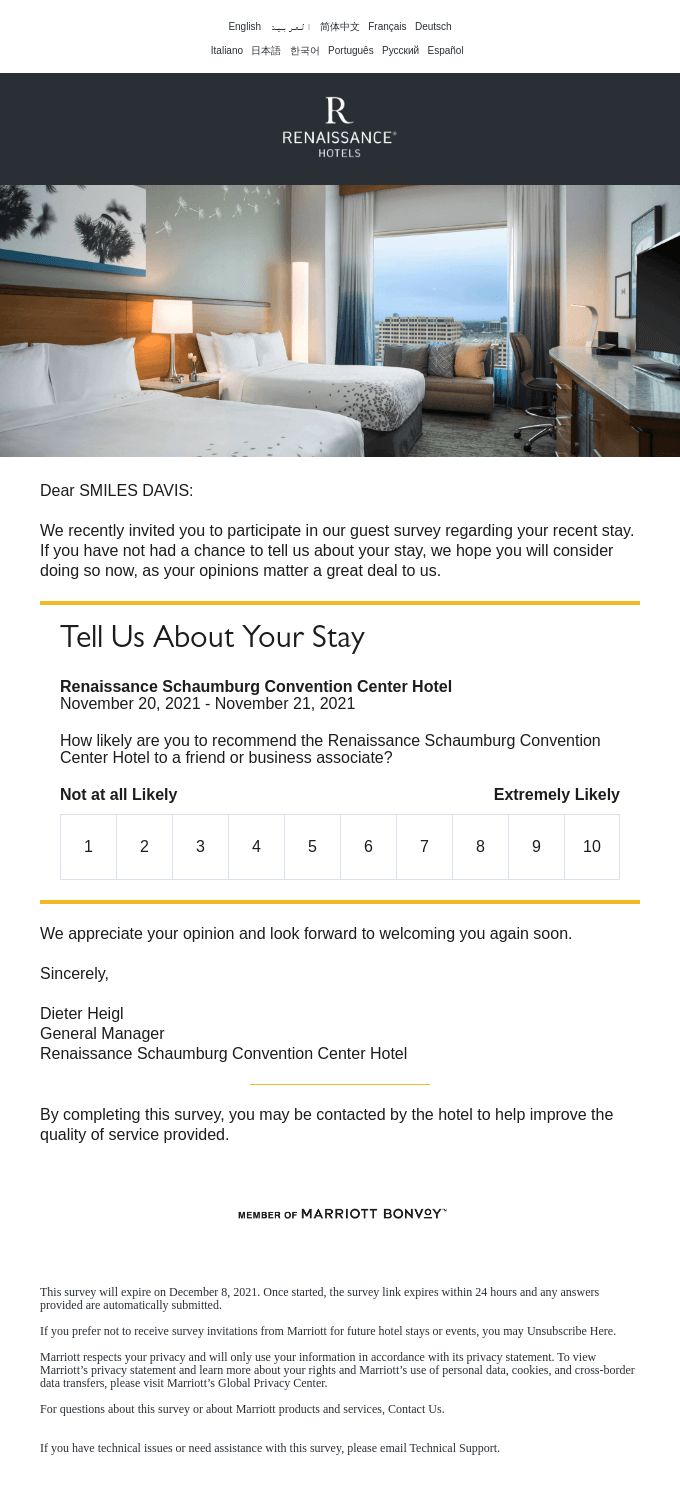
Marriott encourages customers to rate their experience from 1 to 10. Really Good Emails
Feel free to play around with the wording and add additional questions if you want to. You could even offer your customers a discount for filling out the survey, as Anthropologie did in this example.
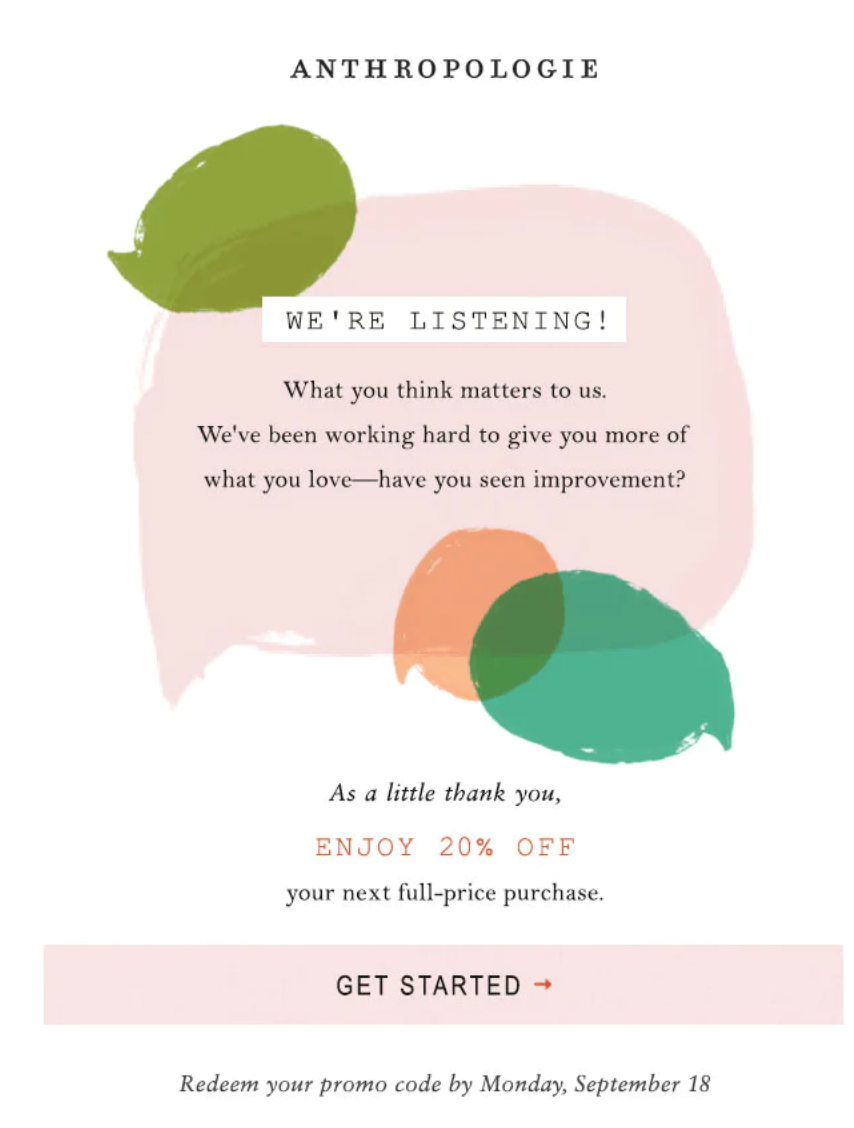
Anthropologie gives shoppers 20% off if they share their feedback. Really Good Emails
No matter what kind of survey you send out, the real value is how you act on the results.
For customers who are likely to recommend the product (i.e., they answered with a nine or a 10), you can follow up with them to share affiliate or rewards programs you offer based on their referrals. These are your brand advocates, so nurture those relationships and make them feel valued.
If they’re unlikely to recommend the product, now you know—and you can do something about it. When you get answers that fall under a five, you can follow up directly and ask if there’s anything you can do to fix the issues your customer is having.
Sometimes, the answer is no, but you can turn some quietly disgruntled customers into fans with a simple fix like a replacement or a discount on their next purchase. It’’s all about showing you care and are willing to go the extra mile to make things right.
If you never ask, you’’ll never know. So start collecting and using that valuable feedback to improve your products, customer service, and overall brand experience.
6. Customer information emails
When customers order from you, they give you a fair bit of information about themselves. You’ve got their name, address, and order history; you might even have tracked their behavior using marketing software.
You can always learn more about your customers, and one of the easiest ways to do this is to ask.
That’’s what Bespoke Post did. The company sells themed subscription boxes for men, so it wants to ensure each box is tailored to each customer’’s interests. Rather than guessing and potentially sending out boxes that aren’t a good fit, it emailed current subscribers.
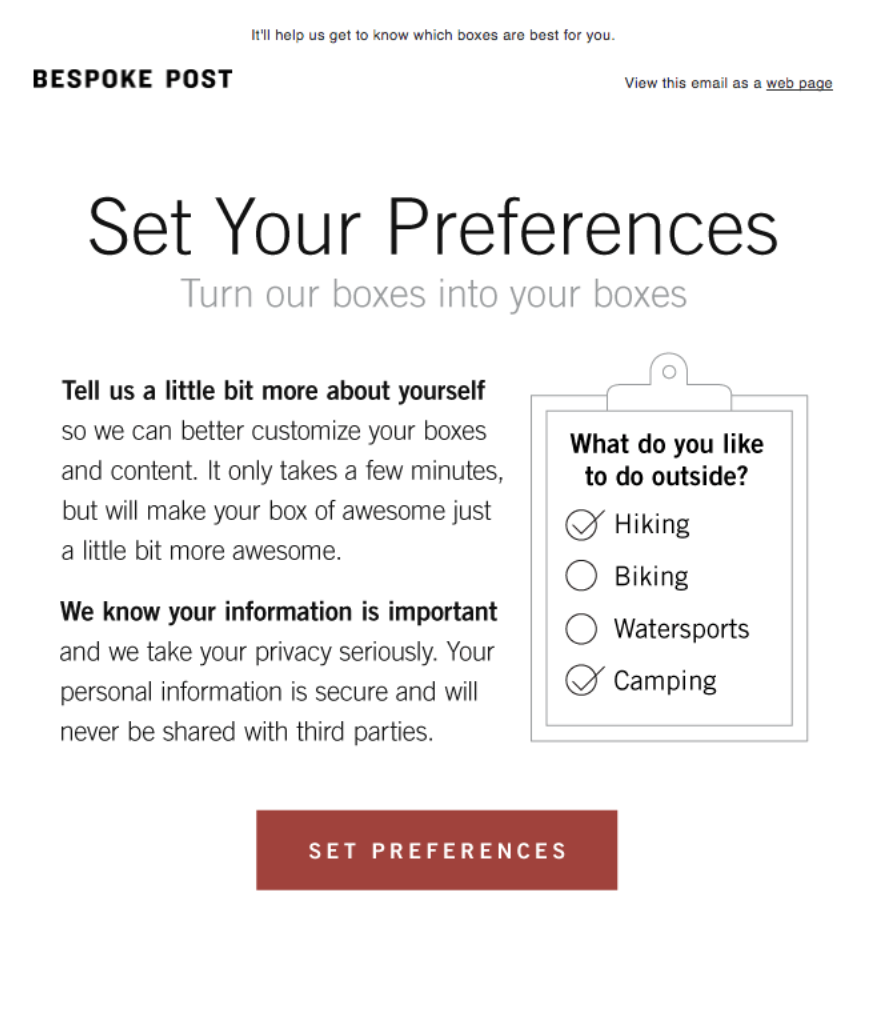
Bespoke Post lets customers customize their experience. Really Good Emails
You don’’t need to sell a subscription box to make this post-sales email work for your store. Ask your customers any questions that can help you segment your emails better, such as:
- Which product lines do they typically buy?
- What activities do they enjoy?
- What sizes do they wear?
- How much do they know about a specific topic?
Once you have that information, you can tailor your emails to reach relevant customers—the ones most likely to take you up on your newest offer, sale, or product. It’’s all about delivering a personalized experience that shows you understand their needs and preferences.
7. Surprise and delight emails
At any stage of your business, you’ll have repeat customers who stand out above the rest.
Maybe they’re active on social media promoting your products or bought five times more products than your average order volume. However you measure who counts as a superstar customer, once you know who they are, you can use email to go above and beyond to show your appreciation.
There are plenty of ways to offer exclusive perks to your best customers. Choose from options like:
- A personalized note. Write a simple, heartfelt email from your personal account to say thanks, and explain why you’’re thanking them.
- Exclusive access to you. If it makes sense for your customers and brand, consider offering a few of your best customers the chance to connect with you one-on-one.
- A gift. Send customers a bonus, surprise freebie, or discount code to apply to their next order to claim their gift.
- A coupon. Set up a special discount for your best customers and surprise them.
Outdoor Voices rewards its best customers with vouchers and money off, showing that it values their loyalty and wants to keep them returning for more.
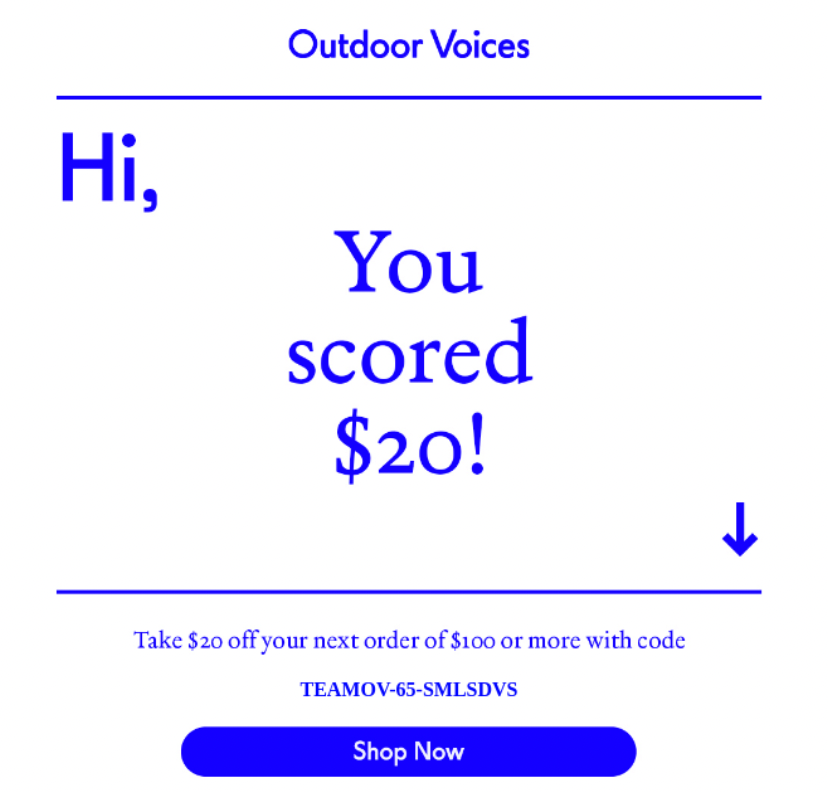
Outdoor Voices rewards its best customers with money off their next order. Really Good Emails
The key to surprise and delight emails is to make them feel exclusive and unexpected. You want your customers to feel like they’’re part of a special club and that you genuinely appreciate their business. So get creative, have fun with it, and show your customers some love!
8. User-generated content emails
It’s not easy to build loyal fans out of your customers, so once they are your fans, why not have them share the love? As part of your follow-up emails, you can ask them to share your products, via user generated content (UGC) on social media platforms like Instagram or TikTok.
Here’s one example from Lush Cosmetics: It prompts its customers to share photos with a hashtag specific to a single product line in exchange for a discount.
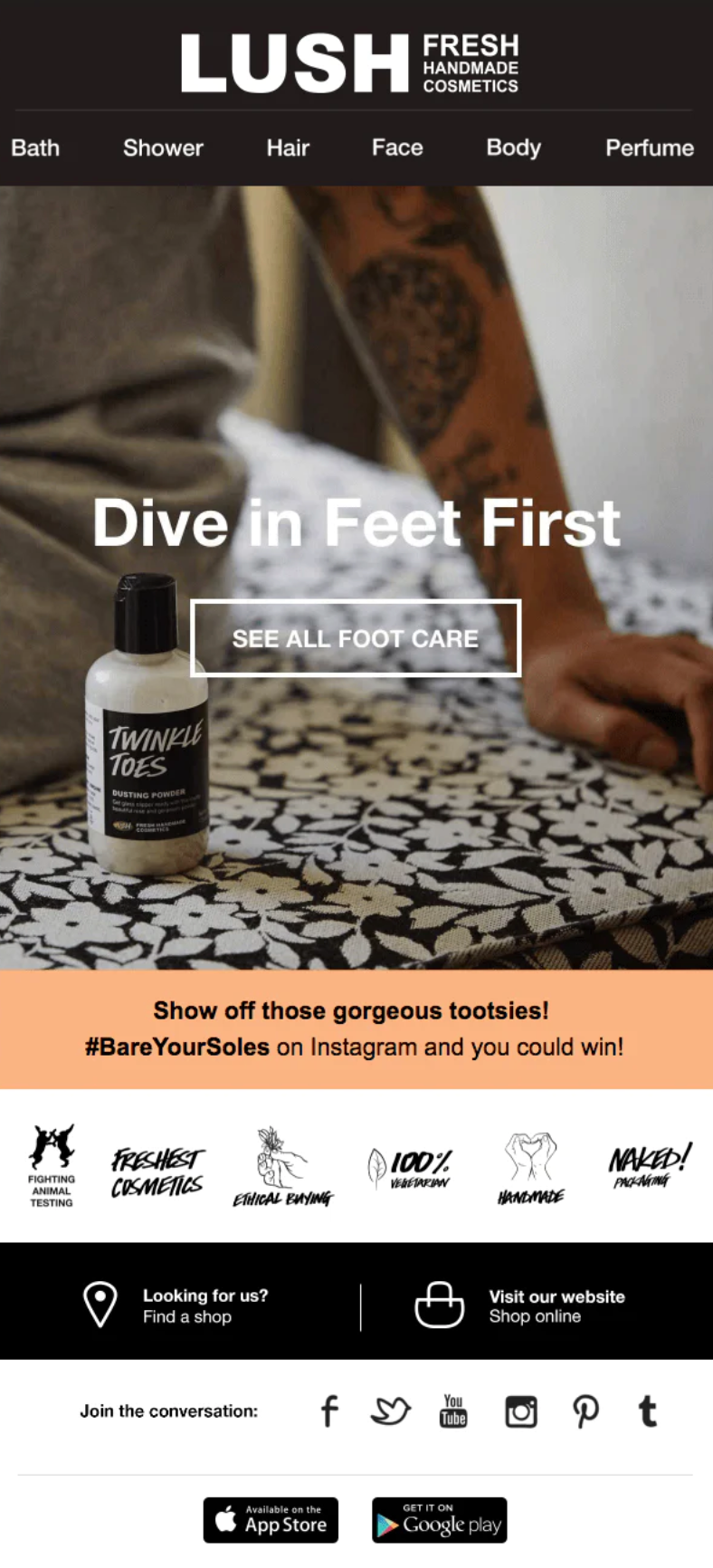
Lush encourages customers to share UGC on social media. Really Good Emails
To build your email to encourage your customers to share the love on social, consider:
- Which platforms are the best fit for your product and your audience?
- Do you want to include an incentive?
- What hashtag will you use to find their posts?
Once you know the answers, write an email asking them to share their stories about your product. You could even segment your customers by the product they bought to make more specific requests or segment them by their answers to your survey if you’ve imported that data into your email system.
Be bold about asking your customers to spread the word. User-generated content is a powerful way to build social proof and attract new customers. Plus, it’’s a great way to show your existing customers you value their opinions and experiences.
FURTHER READING: Learn more about how segmenting your email list can help you drive sales and increase customer engagement.
9. Upsell/cross-sell
Upselling involves getting customers to buy more expensive, upgraded, or premium versions of items to earn more money. Cross-selling involves recommending products based on customers’’ recent purchases. Both strategies make for powerful post-purchase email automation.
These emails make finding new products more accessible. Customers can view these products in a noninvasive manner, and you’re also not selling people unnecessary items. The products are personalized to the customer’s behavior and may improve their purchases.
Dollar Shave Club uses a cross-sell/upsell strategy when sending its monthly replenishment email for its subscription box. Customers receive an email with the option to add more related products to the ones in their box.
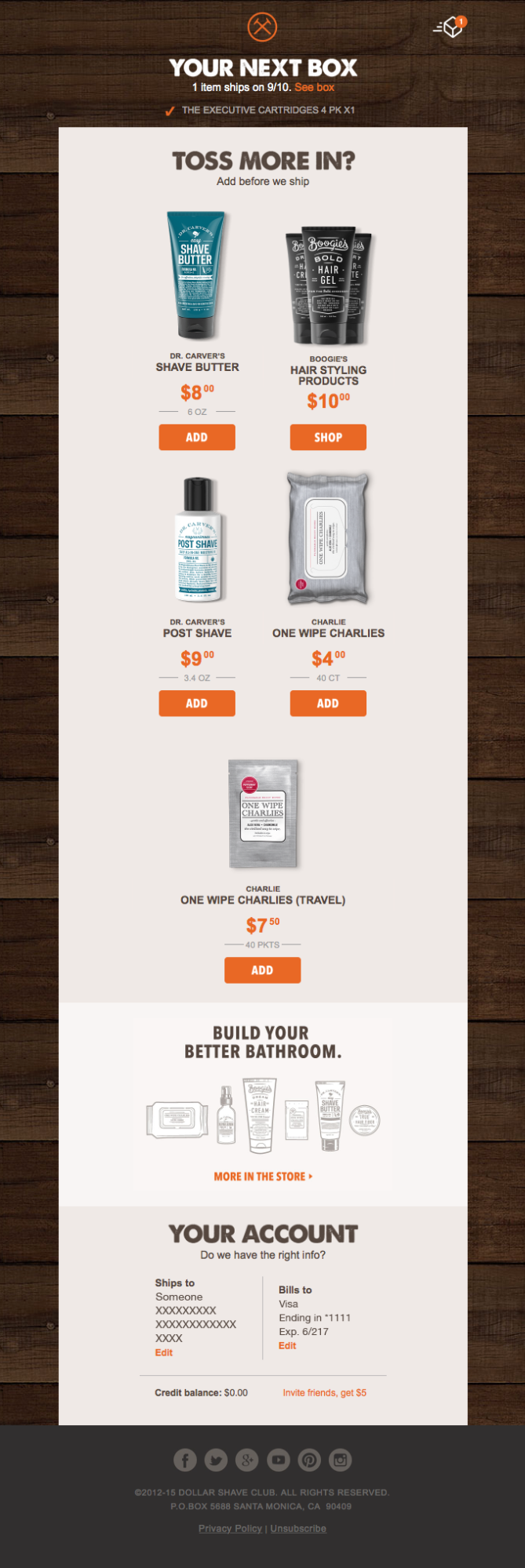
Dollar Shave Club cross-sells relevant products when shoppers make a purchase. Really Good Emails
If you’’ve done your homework and truly understand your customers’ needs and preferences, they’’ll appreciate the personalized recommendations. Just make sure you’’re not coming across as pushy or salesy. Frame your upsell and cross-sell emails as helpful suggestions rather than hard sells.
Why are post-purchase emails important?
Enhance customer service
Post-purchase emails can reassure customers by acknowledging their order and providing transparency about what happens next. Sixty percent of shoppers track their orders daily, while 17% check more than once daily. Instead of going quiet, share further information about shipping, delivery, and additional items they might like. Your customers will appreciate the proactive communication and feel more confident in purchasing.
Boost customer retention
Post-purchase emails generate 90% higher revenue per recipient than your average email campaign because continued engagement via email positively impacts customer loyalty and encourages repeat purchases.
Sending personalized notes or special offers can increase the likelihood of customers returning. Nurturing customers in this way is more likely to bring them back in the future because they feel valued. Don’’t underestimate the power of making your customers feel appreciated and understood. It can be the difference between a one-time buyer and a lifelong fan.
Increase sales opportunities
Post-purchase emails can be an excellent platform for cross-selling and upselling because you can recommend related products or promote exclusive deals. According to McKinsey, cross-selling can increase sales by 20% and profit by 30%, respectively, because shoppers add more to their carts and spend more per order.
Gather feedback and improve services
Soliciting customer feedback through post-purchase emails can provide valuable insights into customer satisfaction and product quality. You can use this feedback to improve your products or purchasing journey.
Be bold and ask for feedback, even if it’’s not positive. Every piece of constructive criticism is an opportunity to improve and show your customers you’’re listening. And when you do get glowing reviews, showcase them in your marketing to attract even more happy customers.
How to segment your post-purchase emails
Segmenting customers and tailoring their post-purchase emails to reflect their specific situations, preferences, and interests boosts your chances of making sales. There are two common ways you can segment your post-purchase emails.
1. Demographic segmentation
Like other types of email campaigns, you can segment customers by demographic data and tailor your post-purchase messages based on specific attributes. Segmentation options might include:
- Age
- Gender
- Location
- Life stage
- Job title
Use this information to send personalized product recommendations or upsells for specific age groups or those who live in a particular location. The more targeted your emails are, the more likely they will resonate with your customers and drive sales.
2. Purchase history segmentation
Once a customer has bought a product from you, you can segment them based on specific information like what they bought, how much they spent, and how frequently they returned to purchase from you. This type of segmentation can help you tailor offers and recommendations based on their product preferences, style, or budget.
For example, if someone regularly buys $50 shoes from you in winter, you can send them a targeted email promoting your latest line of $50 shoes as winter approaches.
Post-purchase email campaign benchmarks
The email marketing metrics associated with your post-purchase campaigns will often differ (sometimes wildly) from your regular email marketing campaign results.
According to the latest email marketing benchmark report from Klaviyo, post-purchase emails have an average click-through rate of 61.68%, an average click rate of 3.97%, and an average placed order rate of 0.54%.
This average varies depending on the type of product you sell. For example, brands that sell sporting goods tend to have higher post-purchase open rates (64.44%) than brands in the health and beauty sector (58.67%).
Here are the average open, click, and conversion rates for post-purchase emails in different industries.
| Industry | Open Rate (%) | Click Rate (%) | Conversion Rate (%) |
|---|---|---|---|
| Clothing and accessories | 62.64 | 3.87 | 0.60 |
| Automotive | 63.16 | 5.33 | 0.70 |
| Electronics | 62.09 | 5.24 | 0.53 |
| Food and beverage | 61.18 | 3.85 | 0.63 |
| Hardware and home improvement | 61.76 | 4.66 | 0.63 |
| Health and beauty | 58.67 | 3.25 | 0.43 |
| Home and garden | 64.26 | 4.58 | 0.53 |
| Jewelry | 63.51 | 4.38 | 0.55 |
| Office supplies | 60.54 | 3.19 | 0.43 |
| Sporting goods | 64.44 | 5.15 | 0.66 |
| Toys and hobbies | 61.97 | 4.36 | 0.53 |
These benchmarks provide a solid foundation for setting your post-purchase email campaign goals. However, feel free to aim higher. With the right strategies and a commitment to continuous optimization, you can outperform these averages and turn your post-purchase emails into a powerful driver of customer loyalty and revenue.
7 post-purchase email tips
Need a little extra help crafting the best post-purchase campaign? Here are seven tips from marketing pros to create fun, engaging emails that delight customers.
1. Focus on good copywriting
“One of the best ways to improve your post-purchase email marketing efforts is to make sure they are well written. The vast majority of us are accustomed to the post-purchase email protocol because we make quite a few online transactions,” says Robert Warner, head of marketing at VirtualValley.
“Strong copywriting is essential if you want people to remember you after reading your emails. The objective here is to communicate vital information in a manner that is unmistakable and easy to recall while maintaining a clear and distinct tone.”
Take the time to craft messages that resonate and leave a lasting impression. Don’’t settle for generic, forgettable copy.
2. Make sure your customers are satisfied with their purchase
“Ecommerce businesses will send confirmation emails as a matter of practice but often will drop the ball in ensuring everything arrived to the customer’s satisfaction and miss a sales opportunity. Most businesses that do a great deal of shipping will send a confirmation of purchase as well as one to notify the customer that their order went out, but those do not offer a prime opportunity to sell, as the customer has not had a chance to evaluate the product and service,” says Cody Candee, founder and CEO of Bounce.
“However, by sending a post-purchase email a week after shipping—asking about whether their order arrived and that they were satisfied with the product—not only does it show your concern that the customer’s needs were met, but it also provides you the opportunity to promote similar products and create a more personalized customer experience.
“By sending a post-purchase confirmation email for the receipt of goods, you showcase your business’’s values by putting the customer first, and at the same time, you can play off the customer’s satisfaction with more promotions.”
Take advantage of this crucial opportunity to check in with your customers and ensure they’’re happy with their purchases. Proactive communication can go a long way in building trust and loyalty.
3. Incorporate dynamic order and shipping information in emails
“After making a purchase, customers look through their confirmation emails to find crucial information such as delivery dates, tracking numbers, and order updates. If you can include all of these specifics within the body of the email itself, rather than forcing the recipient to click on a tracking number or log into an account, you will significantly enhance the customer’s overall experience,” says Brian Case, director of ecommerce and retail at Selkirk.
“AMP for Email allows you to incorporate dynamic order and shipping information directly into an email, enabling your consumers to obtain the information they require in a single glance.”
Make it easy for your customers to find the information they need. By directly incorporating dynamic order and shipping details into your emails, you can streamline the post-purchase experience and reduce frustration.
4. Create special flows for international customers
“Those that ship worldwide will need to give your post-purchase emails to your overseas consumers a little more thought to make them as effective as possible. We are all aware that the entire ecommerce shopping experience can become more stressful while waiting for a package to be transported internationally,” says Dean Lee, head of marketing at Sealions.
“Create nurture schedules that account for additional shipment times and include real-time tracking information in your post-purchase emails to streamline the process for your clients.”
Shipping internationally adds an extra layer of complexity to the post-purchase experience. By creating dedicated email flows for your international customers, you can address their unique needs and concerns, keeping them informed and engaged throughout the longer shipping process.
5. Consider the timing of your emails
“Timing is crucial for post-purchase email campaigns. If you fail to send out a delivery dispatch notice following a sale on your Shopify store, your customers will feel left out of the loop,” says Alice Eve, marketing director at Cicinia France.
“Alternatively, notify them when a previous purchase is back in stock, as they may miss out on the opportunity to repurchase it. Set up automated flows to ensure that your emails are delivered to customers on time, every time.”
Don’’t underestimate the importance of timing in post-purchase emails. You can keep your customers informed, engaged, and primed for future purchases by sending the right message at the right moment.
6. Show customers what’s next
“A post-purchase campaign should have details about the order, but it also should answer the “What next?” questions that customers often have,” explains Kim Foerst, digital marketing manager for Lush Decor.
“Customers always want to know when their order will ship. So, beyond the receipt, the email needs to include information about when they will receive shipping confirmations and how long it will take to deliver after it has shipped. Also, they need contact information for the customer service team in case they have a question about the item they just ordered.
“If the item they purchased is part of a collection, show them the rest so they know which shower curtain and valance go together or which coat matches the shoes they purchased, etc. This is a great way to upsell to your customer. And don’t forget to include a coupon code to entice them to order again right away!”
Anticipate your customers’’ needs and proactively address them in your post-purchase emails. Providing clear next steps and showcasing related products can create a seamless, engaging experience that encourages repeat purchases.
7. Segment customers based on behavior
“My number one best tip for improving post-purchase email campaigns would be advanced segmentation based on behavior, value, and demographics. Sending the same email to everyone doesn’t work,” says Jack Bird, director at Let’s Drive Digital.
“Implementing segments that identify patterns in your high-value purchasers—what they buy, where they are, how much they spend, how often they return, which medium they come through—all of this is commercially valuable data that will significantly improve the performance of your post-purchase email campaigns, and that’s because you’re talking to individuals and tailoring your communications to them rather than just sending out generic emails.
“One of the big things we try to teach clients is that, at minimum, everyone who purchases at least once needs to be encouraged to buy at least once more because people who have purchased twice statistically are significantly more loyal and more likely to keep purchasing.
“For example, one large D2C ecommerce brand we work with sees a fivefold increase in customer lifetime value for people who have purchased more than once versus people who purchased only once. Tailored email communications and better segmentation will take you along this journey much quicker and get more of your database purchasing more often.”
Personalization is the key to effective post-purchase email campaigns. You can create highly targeted, relevant messages that resonate individually by segmenting your customers based on their behavior, values, and demographics. This level of personalization can be a powerful driver of customer loyalty and repeat purchases.
Get repeat customer purchases with post-purchase emails
The above examples and tips are an excellent foundation for building campaigns to turn new customers into raving fans, but they’re just one part of your overall fan-creation strategy.
To really build a great customer experience at every touchpoint—not just email—you need to examine everything from your customer service practices to your shipping strategy.
Especially in ecommerce, every interaction you have with your customers is crucial to building a relationship, since you’ll likely never meet every customer in person.
Remember, post-purchase emails are a golden opportunity to strengthen customer relationships and drive long-term loyalty. By implementing the strategies and tips outlined in this guide, you can create post-purchase campaigns that delight your customers, encourage repeat purchases, and, ultimately, boosts your bottom line.
Feel free to experiment, test new approaches, and refine your post-purchase email strategy. With creativity and customer-centricity, you can turn your post-purchase emails into a powerful tool for growth and success.
Post-purchase emails FAQ
What is a post-purchase email example?
Order confirmation emails are prime examples of post-purchase emails. They assure customers their payment went through and that their order is accurate. This builds customer trust and is an excellent way to showcase your brand’s personality and style.
What does post-purchase mean?
Post-purchase refers to the period after a customer places an order with your store. The post-purchase period is a critical stage in the customer journey, as it’’s when you can reinforce their purchase decision, build loyalty, and encourage future purchases.
What is a post-purchase email flow?
A post-purchase email flow is an automated series of emails you send after a confirmed order in your store. For example, thank you, cross-sell, and customer feedback flows. These automated sequences allow you to nurture customer relationships and drive repeat purchases without manually sending individual emails.
When to send a post-purchase email?
Post-purchase emails are typically sent right after a customer has made a purchase. The first email should thank them for placing their order and provide updates on their delivery. You can send follow-up emails after this to recommend other products they like and ask for feedback or a review. The timing of these follow-up emails will depend on your products and your customers’’ typical buying cycle, but generally, you’’ll want to send them within a few days to a few weeks after the initial purchase.
